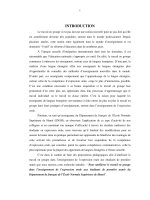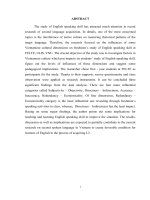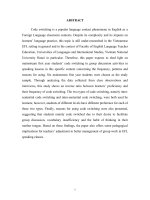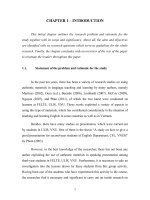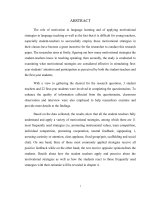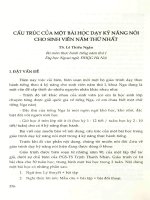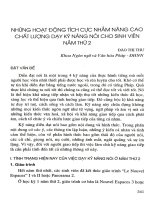Sự lo lắng trong giờ học kỹ năng nói của sinh viên năm thứ nhất chuyên ngành tiếng anh tại một trường cao đẳng sư phạm ở việt
Bạn đang xem bản rút gọn của tài liệu. Xem và tải ngay bản đầy đủ của tài liệu tại đây (1.08 MB, 79 trang )
VIETNAM NATIONAL UNIVERSITY, HANOI
UNIVERSITY OF LANGUAGES AND INTERNATIONAL STUDIES
FACULTY OF POST - GRADUATE STUDIES
----------------------------
NGUYỄN THỊ CHÂM
ANXIETY IN ENGLISH SPEAKING CLASSES EXPERIENCED BY
ENGLISH MAJORED FRESHMEN AT A TEACHER TRAINING
COLLEGE IN VIET NAM
(Sự lo lắng trong giờ học kỹ năng nói của sinh viên năm thứ nhất chuyên ngành
tiếng Anh tại một trường cao đẳng sư phạm ở Việt Nam)
M.A MINOR PROGRAMME THESIS
Field: English Teaching Methodology
Code: 8140231.01
Hanoi – 2018
VIETNAM NATIONAL UNIVERSITY, HANOI
UNIVERSITY OF LANGUAGES AND INTERNATIONAL STUDIES
FACULTY OF POST - GRADUATE STUDIES
----------------------------
NGUYỄN THỊ CHÂM
ANXIETY IN ENGLISH SPEAKING CLASSES EXPERIENCED BY
ENGLISH MAJORED FRESHMEN AT A TEACHER TRAINING
COLLEGE IN VIET NAM
(Sự lo lắng trong giờ học kỹ năng nói của sinh viên năm thứ nhất chuyên ngành
tiếng Anh tại một trường cao đẳng sư phạm ở Việt Nam)
M.A MINOR PROGRAMME THESIS
Field: English Teaching Methodology
Code: 8140231.01
Supervisor: Dr. Ngô Thu Hương
Hanoi – 2018
DECLARATION
I hereby certify that the study entitled “Anxiety in English speaking classes
experienced by English majored freshmen at a teacher training college in
Vietnam” is the result of my own work in the fulfillment of the requirements for the
Degree of Master of Arts at the University of Languages and International Studies,
Vietnam National University, Hanoi.
Hanoi, 2018
Nguyễn Thị Châm
i
ACKNOWLEGDMENT
My study has been completed with the assistance and guidance of a number
of significant people. I would like to acknowledge them here.
First of all, I would like to express my sincere gratitude to my supervisor, Dr
Huong Ngo for her valuable suggestions, academic guidance, and critical comments
on my study. Without her support, I would not have been able to complete this
study.
Moreover, I am grateful to the lecturers and staff at the Faculty of Postgraduate Studies, at the University of Languages and International Studies, Vietnam
National University, Hanoi. Their inspiring lectures, together with their tireless
academic support and encouragements have been a great motivation for me to
realize the dream of completing my higher study.
Furthermore, my thanks also go to the students who participated in my
research. Their willingness to support will be always remembered.
Last, I wish to acknowledge the support and invaluable help of my family
while the work was in progress. They have been part of my interesting journey.
ii
ABSTRACT
The present study aimed to investigate anxiety in English speaking classes
experienced by English majored freshmen at a teacher training college in Viet Nam.
This study used a mixed methods design to achieve its research aims. In the
quantitative phase, a questionnaire was administered to a group of 46 first year
English major students at the teacher training college. The aims of the quantitative
study were (1) to measure the level of anxiety when students studying speaking
skills, (2) to measure students‟ motivation to learn English speaking skills and the
level of students‟ self-perceived speaking proficiency reported by the students and
(3) to examine the correlations between students‟ level of anxiety and their
motivation and self-perceived English speaking proficiency. In the second phase,
the qualitative study employed a number of semi-structured interviews with seven
participants. The interviews sought to understand the sources of anxiety in speaking
classes and solutions to alleviate anxiety in English speaking classes.
This study found that freshmen experienced a moderate level of anxiety in
speaking classes, a moderate level of motivation in learning English speaking and a
low level of self-perceived speaking proficiency. The findings revealed that there
was a negative and significant correlation between speaking anxiety and motivation
in learning English speaking. The findings also revealed a negative and significant
correlation between speaking anxiety and students‟ self-perceived English speaking
proficiency. The five solutions were suggested to reduce students‟ anxiety in
speaking classes. The study is expected to contribute to the enhancement of
teaching speaking skills and help to improve students‟ speaking participation and
speaking‟s ability at my college in particular and in Vietnamese school in general.
iii
LIST OF ABBREVIATIONS
CEFR
Common European Framework of Reference for Languages
CLT
Communicative Language Teaching
FLCAS
Foreign Language Classroom Anxiety Scale
RQ
Research Question
iv
LIST OF TABLES
Table 3.1. Mean levels, Standard deviation and Cronbach Alphas for three
Subtypes of Anxiety ...................................................................................................28
Table 3.2. Mean levels, standard deviation and Cronbach Alphas for Motivation,
Students’ Self-perceived of Spoken Interaction and Students’ Self-perceived of
Spoken Production ....................................................................................................29
Table 3.3. Correlations between the three Subtypes of Anxiety and Students’ Selfperceived Speaking Proficiency ................................................................................30
Table 3.4. Correlations between the three Subtypes of Anxiety and Students’
Motivation .................................................................................................................31
v
TABLE OF CONTENTS
DECLARATION ........................................................................................................ i
ACKNOWLEGDMENT...........................................................................................ii
ABSTRACT ............................................................................................................. iii
LIST OF ABBREVIATIONS.................................................................................. iv
LIST OF TABLES .................................................................................................... v
PART A: INTRODUCTION .................................................................................... 1
1. Rationale .................................................................................................................1
2. Aims of the study ....................................................................................................2
3. Significance of the study .........................................................................................2
4. Research questions .................................................................................................3
5. Scope of the study ...................................................................................................3
6. Method of the study ................................................................................................3
7. Structure of the study ..............................................................................................4
PART B: DEVELOPMENT..................................................................................... 5
CHAPTER 1: LITERATURE REVIEW ................................................................ 5
1.1. Foreign language learning anxiety .......................................................................5
1.1.1. Definition and types of anxiety .........................................................................5
1.1.2. Anxiety in foreign language learning................................................................6
1.1.2.1. Definition of foreign language anxiety ..........................................................6
1.1.2.2. Impact of anxiety on foreign language learning ............................................7
1.2 .Foreign language speaking skills.............................................................................7
1.2.1 Definition of foreign language speaking skills ..................................................7
1.2.2. Approaches to teach foreign language speaking skills .....................................8
1.2.3. Speaking proficiency.........................................................................................9
1.2.4. Factors affect speaking proficiency ................................................................11
1.3. English speaking anxiety ...................................................................................13
1.3.1. Anxiety in English speaking skills ..................................................................13
1.3.2. Sources of foreign language anxiety and speaking anxiety ............................14
vi
1.3.3. Previous studies of foreign language anxiety in speaking skills ....................16
Chapter summary ................................................................................................... 19
CHAPTER 2 METHODOLOGY .......................................................................... 21
2.1. Context of study .................................................................................................21
2.2. Research questions .............................................................................................22
2.3. The study ............................................................................................................23
2.3.1. Participants ......................................................................................................23
2.3.2. Data gathering instruments .............................................................................23
2.3.3. Data gathering procedure ................................................................................25
2.3.4. Data analysis procedure ..................................................................................25
Chapter summary ................................................................................................... 26
CHAPTER 3: FINDINGS AND DISCUSSION ...................................................27
3.1. The findings from questionnaires .......................................................................27
3.1.1. The level of students’ speaking anxiety ...........................................................27
3.1.2. The level of students’ motivation in learning speaking and students’ self –
perceived speaking proficiency .................................................................................28
3.1.3. .. Relationship between speaking anxiety and students‟ self-perceived speaking
proficiency.................................................................................................................29
3.1.4. Relationship between speaking anxiety and students‟ motivation ..................31
3.2. The findings from interviews .............................................................................31
3.2.1. . The level of speaking anxiety experienced by freshmen majoring in English at
the teacher training college ......................................................................................31
3.2.2. Sources of English speaking anxiety experienced by freshmen majoring in
English at the teacher training college .....................................................................32
3.2.3. Suggested solutions to reduce anxiety in English speaking classes................35
3.3. Discussion ..........................................................................................................38
Chapter summary ................................................................................................... 44
PART C: CONCLUSION....................................................................................... 45
1. Summary of the key findings ................................................................................45
2. Implications ...........................................................................................................46
vii
3. Limitations of the study ........................................................................................47
4. Suggestions for further study ................................................................................47
REFERENCES ........................................................................................................ 48
Appendices .................................................................................................................. i
Appendix A: Questionnaire ....................................................................................... i
Appendix B: Interview questions ........................................................................... xv
SAMPLED INTERVIEW ..................................................................................... xvi
viii
PART A: INTRODUCTION
1. Rationale
In the global era, English as a language is considered one of the most common
means of international communication in a wide range of areas, including economics,
politics and education. As a result, having a good command of English language is an
advantage, even a must for people in non-English speaking countries like Vietnam.
Recently English has been made to be a compulsory subject at schools and university
in Vietnam. Moreover, in 2008 Prime Minister announced Decision No. 1400/QĐ-TTg
that approved the Plan for “Teaching and Learning Foreign Languages in the National
Education System, Period 2008 to 2020”. The goal of this project is that “by the year
2020 most Vietnamese youth whoever graduate from vocational schools, colleges and
universities gain the capacity to use a foreign language independently. This will enable
them to be more confident in communication, further their chance to study and work in
an integrated and multi-cultural environment with variety of languages. This goal also
makes language as an advantage for Vietnamese people, serving the cause of
industrialization and modernization for the country” (MOET, 2008, p.1). Having such
changes in its foreign language policy, the Vietnamese government believed that it
could help improve Vietnamese people‟s English language proficiency levels,
enabling them to confidently use English to communicate in the international
communication. However, despite many attempts made by the Vietnamese
government, research has indicated that Vietnamese people still demonstrate limited
levels of English proficiency. The English capacity of Vietnamese people is limited
(To, 2010). According to Le (2013) the English language proficiency of college
students is very low and “many college graduates do not meet the foreign language
requirement of the recruiters” (p.66). Le pointed out that the level of college students‟
is lower-intermediate after 240 hours of general English. That is, they struggle with
using English at work. They feel anxious when communicating with foreigners and
believe English speaking skills are among the most difficult skills when they learn
1
English. Mounting evidence has indicated a strong relationship between language
learning anxiety and language proficiency levels. Specifically, Iakovos (2009) found
that the students rather remain silent, mostly withdrawn and do not like to participate
in classroom activities. In fact, it is well recognized that foreign language anxiety is a
rather pervasive phenomenon (Aida, 1994). Also, anxiety prevents a learner from
achieving a high level of proficiency in a foreign language (Scovel, 1991). As a
teacher of English, this concerns me. Through a number of observations conducted
during my English lessons, I have realized that my students often experience language
anxiety in speaking lessons. It is questionable if my students‟ limited levels of English
proficiency, particularly that for oral skills, is caused by their anxiety when learning
English. While this topic has been researched extensive in other countries, research
into this area in Vietnam is scant.
The aforementioned reasons have encouraged me as a teacher of English at the
college to conduct research investigating Vietnamese students‟ English speaking
anxiety which is titled “Anxiety in English speaking classes experienced by English
majored freshmen at a teacher training college in Vietnam”. Hopefully, the
researcher would make the contribution to complete the insightful understanding about
learners‟ speaking anxiety, enhancing teaching and learning English speaking skill,
which can lay a foundation for subsequent research.
2. Aims of the study
The present study has four research objectives. First of all it investigated the
levels of language learning anxiety that students reported when learning English
speaking skills. Secondly it measured the level of students‟ motivation in learning
speaking and students‟ self - perceived speaking proficiency. Thirdly it examined the
relationship between students‟ language anxiety and their self-perceived English
speaking proficiency and their motivation. Finally, it attempted to seek ways to reduce
students‟ anxiety in speaking classes.
3. Significance of the study
The current study which explored the anxiety in English speaking classes of
majored freshmen at a teacher training college is significant at both practical and
2
theoretical levels. At a practical level, the study identified the students‟ level of
speaking anxiety, the relationship between speaking anxiety and students‟ selfperceived speaking proficiency and their motivation and possible ways to reduce
anxiety in English speaking classes. These findings may help significant others such as
lecturers and students to find ways to reduce students‟ anxiety in speaking classes,
which may help to improve the quality of teaching and learning English speaking
skills. At a theoretical level, the present study complements existing literature of
anxiety as it addressed the gaps in this area. The proposal would be a reference source
for English language teachers when teaching oral skills. Furthermore, the study is
expected to contribute to the enhancement of teaching speaking skills and help to
improve students‟ speaking participation and speaking ability at the college in
particular and in Vietnamese schools in general.
4. Research questions
To achieve aforementioned aims, the study set out to seek answers to the
following research questions:
(i) What is the level of students‟ speaking anxiety?
(ii) What are the levels of students‟ motivation in learning speaking and
students‟ self - perceived speaking proficiency?
(iii) What is the relationship between English speaking anxiety and students‟
self - perceived speaking proficiency and their motivation?
(iv) In what ways can the teachers help reduce the level of anxiety in English
speaking classes?
5. Scope of the study
While foreign language learners may experience foreign language anxiety when
learning all the four skills, this study only investigated anxiety that students have
during their speaking classes. Moreover, due to the limited time, this study only
involved the first year English major students in a teacher training college to
participate in the questionnaires and semi-structure interviews.
6. Method of the study
The current study employed a mixed methods research design, comprising two
phrases. In the quantitative phase, a questionnaire was administered to a group of first
3
year students (N= 46) at a teacher training college. The questionnaire was composed
by a number of scales (1) anxiety in English speaking class adapted from Horwitz et
al. (1986), (2) motivation in learning speaking adapted from Ely (1986), (3) selfperceived speaking proficiency adapted from the CEFR. The questionnaire was used
to measure students‟ levels of English speaking anxiety, their levels of motivation
while learning English speaking skills, their self- perceived English speaking
proficiency levels, which addressed Research Questions (RQ) 1, 2, and 3. The
questionnaire also aimed to examine the relationships between students‟ English
speaking anxiety and their motivation and self-perceived English proficiency. In order
to dig deeper into the answers to the RQs, the qualitative phrase was conducted. A
number of face-to-face individual interviews with students (n = 7) were employed. The
interviews provided more depth to RQ 1, 2, 3. Moreover, the qualitative phase aims to
identify possible solutions that teachers can do to reduce students‟ levels of anxiety
while they are in English speaking classes (RQ4).
7. Structure of the study
The study is made up of three parts: Part A introduction, Part B development,
Part C conclusion.
Part A: Introduction
This part covers the rationale for the study, aims, significance, research
questions, scope, methods, and structure of the study.
Part B: Development
This part is organized around three chapters as follows:
Chapter 1: Literature review synthesizes the theoretical framework of the
studies related to anxiety in foreign language learning anxiety, foreign language
speaking skills and previous studies of language anxiety in speaking skills.
Chapter 2: Methodology of the research presents the context, the
methodology used in this study including the participants, data gathering instruments,
data gathering procedures and data analysis procedures. The detailed results of the
survey and a comprehensive analysis on the data collected are focused.
Chapter 3: Findings and discussion consists of a comprehensive analysis of
the data from questionnaires and interviews and discussion on the findings.
4
Part C: Conclusion gives the conclusion from the results of the findings,
implications, limitation of the study and some suggestions for further study.
PART B: DEVELOPMENT
CHAPTER 1: LITERATURE REVIEW
This chapter starts with a discussion of what anxiety is and its types. Following
this is the definition of foreign language speaking skills, approaches to teach foreign
language speaking skills, speaking proficiency, and factors affect speaking
proficiency. The final section discusses anxiety in speaking skills, sources of foreign
language anxiety and speaking anxiety and then summaries and discusses the research
findings of foreign language anxiety in speaking skills which provide an overall
picture of the anxiety field and help to identify the resarch gaps for the present study.
1.1. Foreign language learning anxiety
1.1.1. Definition and types of anxiety
As a psychological construct, anxiety was described as "a state of apprehension,
a vague fear that is only indirectly associated with an object" (Scovel, 1991, p.18).
Speiberger (1976) distinguished anxiety from fear by pointing out that although
anxiety and fear are both "unpleasant emotional reactions to the stimulus conditions
perceived as threatening," fear is usually derived from a "real, objective danger in the
external environment" while the threatening stimulus of anxiety may not be known.
Much in the same vein Horwitz, and Cope (1986) defined anxiety as “the subjective
feeling of tension, apprehension, nervousness, and worry associated with an arousal of
the autonomic nervous system” (p.125).
Several types of anxiety have been described, two of the most well-known
being trait anxiety and state anxiety. Trait anxiety is a relatively stable personality
trait. A person who is trait anxious is likely to feel anxious in a variety of situations.
State anxiety, on the other hand, is a temporary condition experienced at a particular
moment. A third type of anxiety is situation specific anxiety which is anxiety in
specific situations. Research into language learning anxiety has indicated that language
5
learning be classed as situation specific (MacIntyre and Gardner 1991; Horwitz 2001).
That is, a trait which happens in language learning situations, namely classrooms.
1.1.2. Anxiety in foreign language learning
1.1.2.1. Definition of foreign language anxiety
Anxiety in foreign language learning has been an interest in education research
for the past few decades and there are various definition of anxiety. Horwitz, Horwitz,
and Cope (1986) who are one of the pioneers to conduct a study of the sources of
foreign language anxiety defined foreign language anxiety as “a distinct complex of
self-perception, beliefs, feelings, and behaviors related to classroom language learning
arising from the uniqueness of the language learning process” (p.128). Foreign
language learning process is a unique process, because learners are required to
communicate using a language which they have not mastered perfectly and foreign
language anxiety would take place only in foreign language learning situations. From
this viewpoint, Horwitz et al. assert that language anxiety is unique due to the way it
involves learners‟ self-concepts to communicate competently and to present
themselves genuinely.
Another definition of foreign language anxiety was given by MacIntyre and
Gardner (1994) who defined this linguistic phenomenon as “the feeling of tension and
apprehension specifically associated with second language contexts, including
speaking, listening and learning” (p.284). In other words, foreign language anxiety is
worry and negative emotional reaction aroused when learning or using a second
language (MacIntyre, 1999).
Oxford (1999) stated that language anxiety is simply a passing state of fear
when students have to perform using a second language. However, if anxiety
repeatedly occurs and students associate it with language performance, then anxiety
transforms into a trait rather than a state. Oxford went further that once language
anxiety has evolved into a lasting trait, it can have pervasive effects on language
learning and language performance. Therefore, the learners expect to be anxious in
language learning process.
6
To sum up, from the definitions above, the definition of foreign language
anxiety offered by MacIntyre and Gardner (1994) strongly influences and serves as the
present study background definition as the present study investigates foreign language
anxiety in language learning process, specifically speaking classes, to examine the
unpleasant feelings, tension feeling apprehension that students experience during
English speaking classes.
1.1.2.2. Impact of anxiety on foreign language learning
Research into language anxiety has consistently shown that anxiety can hinder
foreign language production and achievement. When learners have high level of
anxiety, acquisition of foreign language is unlikely to be successful. Indeed, Campell
& Ortis (1991) reported a half of all language students experience a different level of
anxiety. Language anxiety is experienced by learners of both foreign and second
language; research related to language anxiety stated that anxiety posed the potential
problems for language learners because “it can interfere with the acquisition, retention
and the production of the new language” (MacIntyre & Gardner, 1991, p.86). Oxford
(1991) revealed that serious language anxiety may cause other related problems with
self-esteem, self-confidence, and risk-taking ability, and ultimately hampers
proficiency in the second language and automatically affects academic achievement.
Therefore, it is crucial to understand the role of anxiety in language learning.
Language anxiety ranks high among factors that can influence language learning,
regardless of whether the setting is formal or informal. For the case of the present
study, the hypothesis is that the students experience a certain level of anxiety. The
anxious students may attribute their anxiety to the difficulties they face during their
learning. Hence, anxiety would be an barrier against the language learning progress. In
the following section, a discussion on foreign language speaking will be provided.
1.2 .Foreign language speaking skills
1.2.1 Definition of foreign language speaking skills
There are a variety of definitions for the term foreign language speaking skills.
Burns and Joyce (1997) stated that speaking is an interactive process of constructing
meaning that involves producing and receiving and processing information. In this
7
process, speaking form and meaning are dependent on the context in which it occurs,
including the participants themselves, their collective experiences, the physical
environment, and the purposes for speaking. Nunan (2003) defined speaking is the
productive oral skill that consist of producing systematic verbal utterance to convey
meaning. Speaking is oral activity in producing sound that express opinion and
construct the meaning. Therefore, the students can get information and can understand
the meaning of information and the students can share the information to other
students. Likewise, Harmer (2007) defined foreign language speaking is the ability to
speak fluently and presupposes not only knowledge of language features, but also the
ability to process information and language “on the spot”.
1.2.2. Approaches to teach foreign language speaking skills
English language teaching has changed over the years with different methods and
approaches. Traditionally, methodology to teach speaking skills usually meant repeating
after the teacher, memorizing a dialogue, or responding to drills known as audiolingual
method and grammar-translation method. The development of communicative language
teaching (CLT) leaded to the changes of syllabuses and methodology, which are
continuing to shape approaches to teaching speaking skills today.
The audiolingual method emphasizes aural and oral work and includes
memorization of dialogues, pattern drills, and substitution drills to form habits. Also,
the method follows a strict sequence of language skills: listening, speaking, reading,
and writing (Abdel, 2009), and the presentation-practice-production sequence makes
the teacher the center of the classroom (Kumaravadivelu, 2006). Although the method
provides foreign language teachers a framework, the method has a number of
disadvantages. One of the disadvantages is that students often complain about dull,
uninteresting, and mechanical drills (Abdel, 2009). In addition, students do not learn to
communicate spontaneously (Abdel, 2009) and have problems transferring isolated
vocabulary
and
grammar
items
into
real-life
communicative
situations
(Kumaravadivelu, 2006)
Grammar-translation method featured memorization of grammar rules and
vocabulary and application of this knowledge to translation of sentences into the target
8
language. The emphasis was mainly put on reading, not on oral communication in the target
language. The grammar-translation method can help students understand the grammatical
rules of the target language and can help develop students‟ reading and writing skills in the
target language (Chang, 2011). However, the method has been criticized for its teachercenteredness, very little oral work and little use of the target language, reliance on rote
memorization and ignorance of students‟ interests (Chang, 2011).
Regarding CLT, grammar-based syllabuses were replaced by communicative
syllabus with notion, functions, skills, tasks or other non-grammatical units of
organization. Fluency became a goal for speaking course and this could be developed
through the use of information-gap and other tasks that required learners to attempt real
communication strategies and engage in negotiation of meaning, both of which were
considered essential to the development of oral skills. CLT offers learners many
opportunities to use the target language such as pair work, group work, role-plays,
simulations where they must fulfill meaningful communication tasks whose realization is
important and a teacher's attention is focused on the content rather than the form (Harmer,
2007). However, it has been criticized for its focus on fluency rather than accuracy,
avoidance of the first language, and focus on meaning against form (Wu, 2010). In
addition, the major goals of foreign language classes are communicative competence.
Communicative competence presents a big challenge to teachers and students as it
involves real communication with people in authentic contexts. Teachers face the
challenge to create the right kind of interaction for students (Koosha, & Yakhabi, 2013)
because speaking, a major component of communicative competence, has been reported
as one of the main anxiety-provoking activities in the foreign language classroom
(Horwitz et al., 1986) and researchers identified anxiety as one of the challenges faced by
the students in a foreign language classroom (Xiao & Wong, 2014)
1.2.3. Speaking proficiency
There has been a variety of definitions of oral competence or speaking
proficiency. Bygates (1991) defined speaking proficiency as the ability to form
abstract sentences that are produced and adapted to circumstances at the moment of
speaking. Therefore, making rapid decisions and contributions that adequately fit the
situation. According to O‟Maley and Valdez (1996) oral competence referred to an
ability to understand meaning between two or more speakers. Brown and Yule (1983)
9
considered oral competence as an interactive process where a meaning is built on by
producing and receiving processed information.
In foreign language learning it is crucial to assess speaking proficiency of the
learners. The formal assessment of speaking proficiency is often carried out through
performance assessment where the learners can be tested individually or in groups or
pairs. Learners can demonstrate their proficiency by interacting with a partner (face-toface, on the telephone, digitally, a peer-to-peer conversation), or in the format of an
oral proficiency interview. In the oral proficiency interview, a trained examiner is
conducting an interview of the candidate. In the peer-to-peer test, two or more
candidates interact with one another. He and Young (1998) are in favour of language
proficiency interviews which are done with one learner and one assessor, preferably a
native speaker. These interviews are largely question-and-answer based. They argue
that having a native speaker assess a learner is the best way to judge whether someone
is proficient or not.
Proficiency rating scales like the Common European Framework of Reference
for Languages (CEFR) can also be used to assess speaking proficiency. CEFR divides
learners into three broad divisions that can be divided into six levels, A1 to C2, for
each level, it describes what a learner is supposed to be able to do in speaking skills.
A1 (beginner) is a basic ability to communicate and exchange information in a simple
way. A2 (elementary) is an ability to deal with simple, straightforward information
and begin to express oneself in familiar contexts. B1 (intermediate) is the ability to
express oneself in a limited way in familiar situations and to deal in a general way
with no routine information. B2 (upper – intermediate) is the capacity to achieve most
goals and express oneself on a range of topics. C1 (advanced) is the ability to
communicate with the emphasis on how well it is done, in terms of appropriacy,
sensitivity and the capacity to deal with unfamiliar topics. C2 (mastery) is the capacity
to deal with material which is academic or cognitively demanding, and to use language
to good effect at a level of performance which may in certain respects be more
advanced than that of an average native speaker. The CEFR can be used for
assessment in three ways. It can be used for identifying what needs to be tested, how
10
learner performance can be interpreted, and how comparisons can be made (Council of
Europe, 2001, p. 178). The Council states that the Framework “seeks to provide a
point of reference, not a practical assessment tool” (p. 178). North (2014) states that
users can use the CEFR as a starting point for assessment, but should definitely think
about what they want to get out of the assessment and what needs to be tested.
Another way to assess learners‟ speaking competence is the use of can-do
statements or self-assessment form. Self-assessment is also known as self-rating, selfappraisal, self-control, or self-evaluation. Second or foreign language learners are
asked to rate their speaking abilities of performing tasks described in can-do
statements. According to Blanche and Merino (1989) the accuracy of self-assessment
was high, since the values of the correlation coefficients between teacher and selfratings ranging from .5 and higher were not uncommon. Ross (1998), however,
rejected this argument through his meta-analysis of 29 studies on speaking selfassessment. The studies were reported to have effect sizes (i.e., the degree of
association between teacher and self-ratings) of a range of .09 to 0.79. He concluded
that the wide range of the effect size across studies suggested that self-assessment of
speaking is susceptible to extraneous variables. Although there has been debate on
whether learners can or cannot assess speaking ability, there are a great deal of study
used self-assess or self-perceive speaking ability as their scale due to the condition of
the study that the researcher cannot conduct a speaking test to rate the speaking ability
of the participants.
1.2.4. Factors affect speaking proficiency
Cognitive factors
According to Levelt (1989), the speaking processes include conceptualization,
formation, and articulation. Since all the three processes happen simultaneously, it is
possible for learners to make mistakes especially in face-to-face communication.
Therefore their speaking maybe filled with "hesitation, false-starts, grammatical
inaccuracies, and limited vocabulary" (Hughes, 2002, p. 77).
Linguistic Factors
The use of correct form in learning language is important for oral proficiency.
Linguistic factors include several features like pronunciation, grammar, and
11
vocabulary. Mispronouncing the sounds or the stresses and intonations cause
misunderstanding. In addtition, grammar play an imporatnt role in the structure of
English. It is rather difficult for learners to transfer the correct grammar to their
speaking (Larsen-Freeman, 2001). Vocabulary is essential for learners as it acts like
bricks to a building. It is necessary for learners to have a wide range vocabulary in
their long-term memory. In addition, the ability to remember words from one's mind
may cover the speaking fluency (Levelt, 1989).
Motivation
Motivation plays an important role in foreign language learning and it is considered as
a crucial factor influencing the achievement and proficiency of language learning.
Wilona et al. (2010) claimed that there was a correlation between motivation and
speaking proficiency. Indeed, Wilona et al. believed that when language learners were
intrinsically motivated they can achieve higher language proficiency, specifically on
the speaking skills. And it enables them to perform well in their speaking. He
supposed that those who are intrinsically motivated tend to spend some time to
practice the skill by engaging in classroom activities, watching English movies,
listening to English songs, and even having a conversation with a native speaker.
Because they know the importance of the learning process and the will to learn the
language comes within them, they always seek a way to use the language. Therefore,
their speaking skills are improved.
Anxiety
Anxiety has an influence on learner's oral proficiency. Anxiety is the affective
factor that "most pervasively obstructs the learning process. Worrying about being
"wrong, stupid, or incomprehensible" (Brown, 2001, p. 269) completely influences
learners' speaking performance. Most of learners are nervous in class, especially when
they are asked to speak in class without any preparation. “Too much nervousness makes
learners tongue-tied or lost for words” (Shumin, 2002, p. 206) and completely affects
learners‟ achievement in foreign language classroom. Since anxiety stands out as one of
the most important factors for effective language learning especially speaking
proficiency, it is essential that the researcher of the present study investigate the anxiety
12
in speaking classes and seek for the countermeasures to reduce the level of anxiety. In
the following section English speaking anxiety will be discussed in more details.
1.3. English speaking anxiety
1.3.1. Anxiety in English speaking skills
Speaking has been generally recognized as the most anxiety provoking skill
associated with foreign language learning. According to Horwitz et al. (1986), anxiety
is a major obstacle to be overcome in learning to speak another language. Indeed,
Horwitz and Young (1991) points out that speaking is problematic because the
spontaneity allows the speaker no preparation time in which to monitor and correct
what he or she wants to say, thus the risk of being wrong in an oral class is high.
Students with anxiety will have difficulty concentrating and processing input in class
and consequently the output of the language is negatively affected. They tend to
hesitate to volunteer to participate in activities in activities and they are unwilling to
take risks. They are apprehensive, worried and even fearful in the classroom
(MacIntyre & Gardner 1991). Such conditions interfere with learning and anxious
students are thus lack of many opportunities to practice the target language. Anxiety is
therefore considered a major obstacle to developing language skills, and particularly
speaking skills.
When students are nervous, they tend to make more mistakes. The more
mistakes they make, the more nervous they will be, and the less likely they are to
perform well at speaking skills thus resulting in a vicious circle. The relationship
between anxiety and speaking is not difficult to identify. The important question is
whether it is the anxiety that gets in the way of developing good speaking skills or it is
the poor speaking skills that create the anxiety. There is no definitive answer yet
(Allwright & Bailey 1991). What is certain, however, is that anxiety can make the
difference between success and failure in language learning (MacIntyre 2002).
13
1.3.2. Sources of foreign language anxiety and speaking anxiety
According to Aydın (2001) there were four main sources of anxiety in speaking
classes including the learners‟ personal reasons, the teacher‟s manner in the classroom,
learners‟ beliefs and the testing and teaching procedures.
Personal reasons
Personal reasons are related with a learners self-assessment of ability and self
comparison to others. Learners usually evaluate their own capabilities that can be
positive or negative. Research shows that learners‟ negative evaluations promote
anxiety (Price, 1991). However, if this evaluation is positive, it helps learners to
develop their language skills (MacIntyre, Gardner, & Clément, 1997). According to
Kiato (2001) self-assessment of ability refers to self-perception of speaking ability,
and it is considered to be a significant anxiety-provoking factor. Kiation points out that
among all the skills taught in the foreign language class speaking is usually the first
skill that learners compare themselves with peers, teachers and native speakers. Thus,
it is reasonable to consider that low self-perception of speaking ability is likely to be a
source of anxiety.
Self-comparison to others is associated with learners‟ competitive behaviors in
the class (Aydın, 2001). When learners realize that they have weaker language skills
than others, they start to compete with them and this causes them to feel anxious. Yan
and Horwitz (2008) conducted an interview study on how language anxiety functions
in language learning. The researchers found 12 major affinities related to language
anxiety. One of the affinities was the learners‟ self comparisons with their peers. The
majority of the participants reported comparing their language ability to that of others.
Learners’ beliefs
Learners‟ own beliefs about language learning have also been found to be
related to foreign language anxiety and speaking anxiety. Some students may think
that particular skills are more important than others in language learning.
According to Aydın (2001), learners may have unrealistic ideas about language
learning, and these ideas could have negative effects on their achievement. That is,
if learners‟ beliefs do not match the real situations, they may start to feel anxious
14
(Ohata, 2005). Horwitz (1988) found that speaking was perceived as more difficult
than reading, writing, or listening. Kim (1998 as cited in Horwitz, 2001) reported
that students in a conversation class were more embarrassed and anxious than
students in a reading class.
Teachers’ manner
The way the teacher deals with the learners‟ errors is important because
research has shown that learners‟ sense of self-efficacy in language learning and their
motivation are affected by the kind and amount of feedback (positive or negative) they
receive (Williams & Burden, 1997, cited in Aydın, 2001). The teachers‟ manner of
error correction has been assumed to be an anxiety-provoking factor. In addition to
the ways of error correction, some attitudes that teachers may have towards students
have been found to be anxiety-provoking.
Cheng (2005) conducted a study to
investigate the role of teachers‟ manner and characteristics in language anxiety. The
results revealed that teachers who were friendly, relaxed and patient were found to
reduce anxiety. However, teachers who give unexpected quizzes were found to be
anxiety-provoking. In addition, being a poor communicator, unpredictable and rigid
were some anxiety-provoking teacher characteristics. When the teacher ignores the
efforts that some students make or only praises successful students, it can cause
anxiety (Aydın, 2001).
Teaching and testing procedures
Speaking classes usually involve several different activities such as role plays,
pair work or presentations that require learners to participate orally. Research has
shown that learners feel rather anxious when they are supposed to speak in front of the
teacher and the class, and the majority of learners find giving presentations anxiety
provoking (Aydın, 2001; Woodrow, 2006; Young, 1991). The main reason for getting
anxious in giving presentations is “the feeling of conspicuousness and fear of negative
evaluation” (Aydın, 2001, p. 111). The study conducted by Cheng (2005) indicated
that speaking in front of the class was the major anxiety-provoking factor. In addition
to public speaking activities, being called on by the teacher has been found to be
another anxiety-provoking situation. Wörde (2003) found that the participants did not
15
